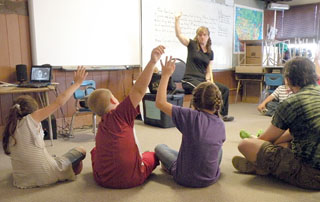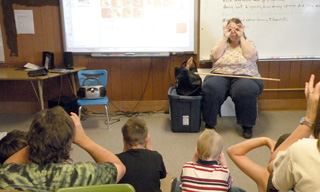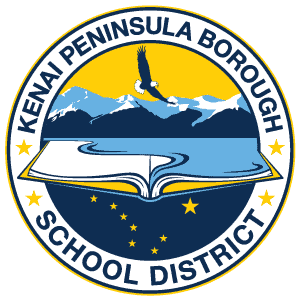Extended school year is extended fun for students
In movies and TV shows, summer school usually gets a bum rap. As the movies go, it’s inflicted as punishment for school-year laziness, shattering the promise of endless free hours of sun and fun that otherwise await students upon the final bell of the spring quarter.
That couldn’t be farther from the case in the Kenai Peninsula Borough School District’s Extended School Year program, which meets three days a week for seven weeks in locations around the district.
“He loves it. If he had a preference he’d be here five days a week,” said Amber Lathrop, whose 8-year-old son attended the ESY program at Soldotna Elementary School.
Her son is one of about 100 students, ages preschool to 21, who participated in the KPBSD program. It’s operated by about 15 teachers and associated service providers, such as occupational and speech therapists, at centralized sites around the district, including Soldotna, Seward, Homer, Seldovia and some of the smaller, more geographically isolated schools.
The program isn’t anything like the dreaded summer school of teen movies, where students are stuck in dark, stuffy classrooms while the sun shines outside, having to suffer through droning lectures, memorize dusty textbooks, and sustain hand cramps from filling out worksheet after worksheet.

If anything, the extended school year program is even more fun than regular school, with more recess time, more opportunity for music and art projects, and more group activities.
“It’s a lot more flexible so we get to spend more time playing outside, and we do a lot of pulling kids together in groups, and doing music,” said Kelli Creglow, a teacher at Soldotna Elementary who also instructs during the ESY program.
The goal of the program also doesn’t quite fit the mold summer school is sometimes put in. It’s not about kids stepping backward and redoing work not completed during the school year. It’s about maintaining momentum to keep student progress rolling forward into the next school year.
The program is for special education students, identified as being at risk of losing already—established skills or losing ground in their progress toward solidifying new ones if they go too long without the regular instruction and practice school provides.
“Everybody knows when they aren’t in school kids lose ground,” Lathrop said. “When your kid’s already one to two grade levels behind, you can’t afford to lose that. So we’re trying to just maintain with minimal loss.”
Each student in the program has a few customized areas to focus on in the extended school year program, as a continuation of their individualized learning plan from the school year.
“We get to do a lot in such a little amount of time because the kids only have a couple of goals to work on. We can work on those and do a lot of other things we don’t necessarily get to do in the school year because there’s so much more we have to work on,” Creglow said.
Some are academic goals, like phonetics and reading comprehension; others are self-sufficiency skills, like tying shoes. A big part of the program is working on social skills in interacting with others. Advancing a grade can be daunting, especially for preschool students in special education programs used to smaller group sizes than they’ll find in mainstream kindergarten classes. The summer program is an opportunity to smooth that transition.
“Because we have more time we get to work a lot more on social skills, which is what I think these kids really need, especially these kids going into kindergarten, to work on how to be in large groups and play together,” Creglow said.
Outside at recess, Creglow smoothly diffused disagreements about sharing the slide, counseled against saying things that may hurt a friend’s feelings and negotiated the return of a stolen shoe.

Inside, Shannon Dwyer and Mike Reid used a transition between an exercise matching letter sounds with animal names—ssssnakes, and butterflies that ffflap their wings—and a discussion of astronauts and outer space to talk about tolerance of differences.
“We don’t have to all like the same things, we don’t have to not like the same things,” Dwyer said, when one student stated a preference that another student did not share.
“I don’t like chocolate ice cream,” announced Reid.
“What?” Dwyer replied. “That’s surprising, but that’s OK if he doesn’t like it. I don’t have to make him like chocolate ice cream, do I? Even if I love chocolate ice cream. If Mr. Mike doesn’t like it, that’s OK.”
“And she likes chocolate ice cream, and that’s OK too. I still like her. We’re still friends,” Reid said.
Interactions like that may not seem like concrete, watershed leaps of educational achievement—like memorizing a times table or scoring perfectly on a spelling test. But learning is more a progression of small steps, taken day after day, that keep heading along the path of progress. In ESY, keeping that regular activity going is key.
“It continues to allow these kids to have some kind of routine through the summertime. These guys tend to need routine structure,” Creglow said. “Most of the time they just don’t get it in the summer because the families are so busy they don’t have the opportunity to set up a schedule for the kids and use the tools we have available here at the school.”
“Routine” to some may be another word for “boring.” But for kids who have challenges in learning, maintaining a schedule can give a sense of security and comfort, which makes it easier to take in new information and face new challenges.
“These kids don’t handle change well, so for them to have a set schedule is great. He wants to know that he’s got OT (occupational therapy), PT (physical therapy) and speech in the morning, and then he has lunch,” Lathrop said. “There isn’t homework or a lot of new lessons. It’s just mainly fun and to keep the schedule consistent. Especially for families that have kids with more severe disabilities, it’s really difficult because they need that structure and that’s hard to do in the summer.”
The effectiveness of the program is seen over the course of the summer, and especially as school reconvenes in the fall.
“I think it’s doing a fantastic job. I think the kids that attend this program are coming back into school ready to be in school again and not starting from a lesser place than when they left,” said Clayton Holland, pupil services director for KPBSD. “We see a lot of student growth in their IEP goals and objectives, as well as the state measures that we track. I think it’s just part of what this district does to make sure every kid has success.”
